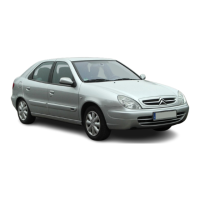U
The Citroën Guide Suspension: A Suspension Primer 19
A Suspension Primer
From the early days of the automobile—and even
before, in the time of horse-drawn carts—it was
already well known that the body of the car, hous
-
ing both the passengers and the load, has to be
decoupled from the unevenness of the road sur
-
face.
This isolation is much more than a question of comfort. The
vertical force of the jolts caused by the repeating bumps
and holes of the road surface are proportional to the square
of the vehicle speed. With the high speeds we drive at to
-
day, this would result in unbearable shock to both people
and the mechanical parts of the car. Jolts in the body also
make it more difficult to control the vehicle.
Consequently, there has to be an elastic medium be
-
tween the body and the wheels, however, the elasticity and
other features of this suspension medium are governed by
many, mostly contradicting factors.
The softer, more elastic the spring, the less the sus
-
pended body will be shaken by various jolts. For the sake of
comfort, we would thus need the softest spring possible.
Unfortunately, too soft a spring will collapse under a given
weight, losing all its elasticity. The elasticity of the spring
would need to be determined as a function of the weight
carried but the weight is never constant: there is a wide
range of possible load requirements for any car. On one
hand, a hard suspension will not be sensitive to load varia
-
tions but being hard, will not fulfill its designated purpose,
either. A soft suspension, on the other hand, is comfortable
but its behavior will change significantly on any load varia
-
tion. To cope with this contradicting requirements, an elas
-
tic medium of decreasing flexibility would be required: such
a spring will become harder as the weight to be carried in
-
creases.
When the spring is compressed under the weight of the
load, it’s not only its flexibility that changes. The spring de
-
flects, causing the clearance between the car and the road
surface decrease, although a constant clearance would be a
prerequisite of stable handling and roadholding. At first
sight, this pushes us towards harder springs: soft springs
would result in excessive variations of vertical position — un
-
less, of course, we can use some other mechanism to en
-
sure a constant ground clearance.
In addition to the static change caused by load varia
-
tions, the deflection of the spring is changing constantly
and dynamically when the wheels roll on the road surface.
The body of the vehicle dives, squats, rolls to left and right
as the car goes over slopes, holes and bumps in the road,
corners, accelerates or decelerates.
When a deflected spring is released again, the energy
stored in it will be released but as there is no actual load for
this energy, the elastic element, the mass of the suspension
and the vehicle form an oscillatory system, causing a series
of oscillations to occur instead of the spring simply return
-
ing to its neutral position.
Any vertical jolt would thus cause such oscillations: the
upward ones are transmitted to the car body while the
downward ones make the wheels bounce, losing contact
with and adhesion to the road surface. The first is only dis
-
comforting, but the second is plainly dangerous. In addi
-
tion, it’s not only the spring that oscillates; the tires contain
air which is a highly elastic spring medium. Oscillation in it
-
self causes unwanted motion but when the corrugation of
the road surface happens to coincide with the period of the
suspension oscillations, it might lead to synchronous reso
-
nance, a detrimental situation leading to serious damages
in the suspension elements.
Mass in motion can also be viewed as a source for kinetic
energy; because of this, moving parts of the suspension are
often reduced in weight to decrease this portion of the
stored energy, and this in turn eases the requirements on
the dampers as they have to dissipate less unwanted energy
as heat. This solution, however, often shifts the frequency
of the self-oscillation of the suspension upwards. Unfortu
-
nately, occupants are more sensitive to higher frequencies
reducing comfort (mostly adding noise), so this is an area
where compromise is needed.
Conventional suspension systems use a second element,
a shock absorber to dampen these oscillations. The ab
-
sorber uses friction to drain some of the energy stored in
the spring in order to decrease the oscillations. Being an ad
-
ditional element presents new challenges: the characteris
-
tics of both the spring and the absorber have to be
matched carefully to obtain any acceptable results. The ab
-
sorber ought to be both soft and hard at the same time: a
soft absorber suppresses the bumps of the road but does
not decrease the oscillations satisfactorily while a hard ab
-
sorber reduces the oscillations but lets the passengers feel
the unevenness of the road too much. Due to this contradic
-
tion, conventionally suspended cars have no alternative but
to find a compromise between the two, according to the in
-
tended purpose of the car: sport versions are harder but of
-
fer better roadholding, luxurious models sacrifice roadhold
-
ing for increased comfort. This contradiction clearly calls for
a unified component serving both as a spring and an
absorber, harmonizing the requirements.

